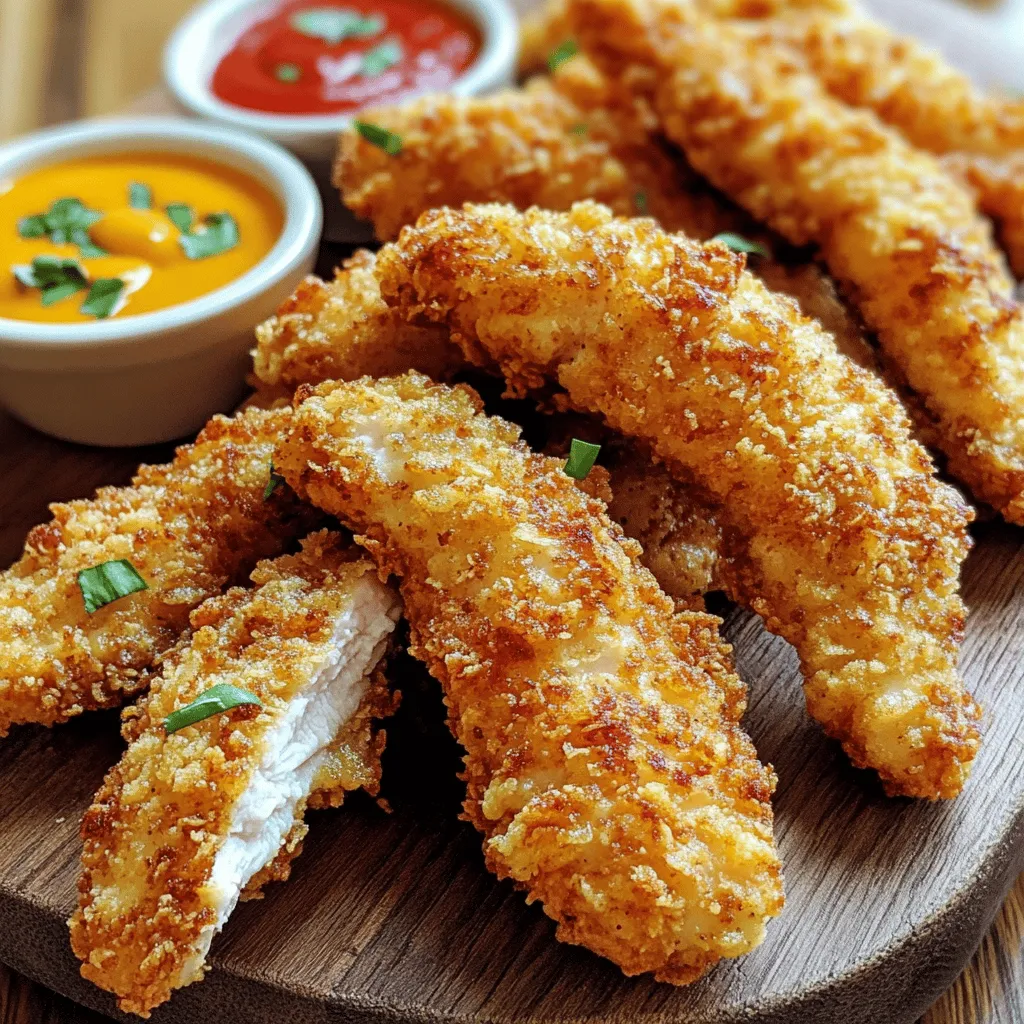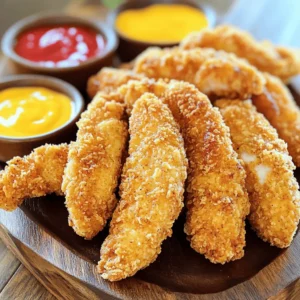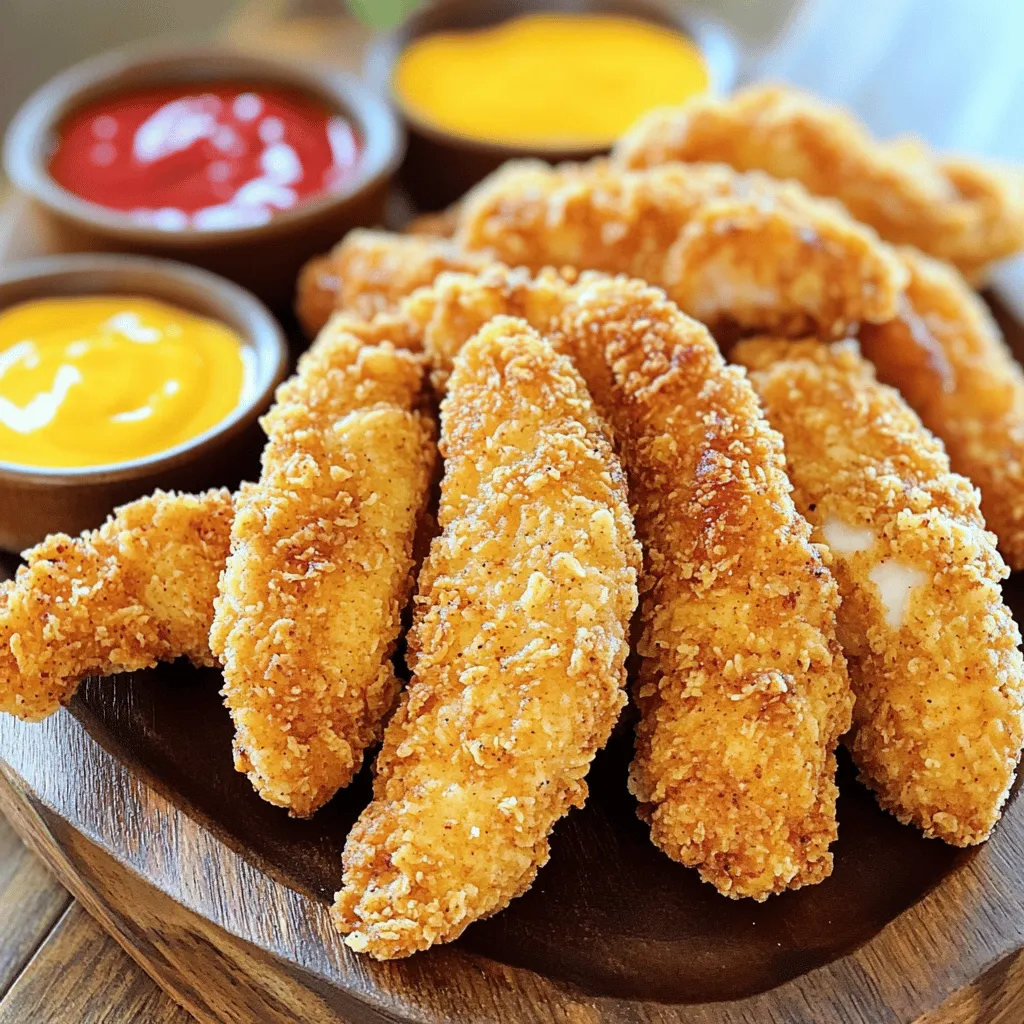Are you ready to make the perfect buttermilk chicken tenders? This juicy and flavorful recipe will elevate your dinner game. I’ll guide you through each step, from marinating to frying, ensuring a crisp coating every time. Plus, I’ll share tips for storage and delicious dipping options. Whether you’re a kitchen pro or a beginner, these tenders will impress your family and friends. Let’s get cooking!
Ingredients
Essential Ingredients for Buttermilk Chicken Tenders
To make buttermilk chicken tenders, you need fresh, quality items. Here are the main ingredients:
– 1 lb chicken breast, cut into strips
– 1 cup buttermilk
– 1 teaspoon garlic powder
– 1 teaspoon onion powder
– 1 teaspoon paprika
– 1 teaspoon salt
– 1/2 teaspoon black pepper
– 1 cup all-purpose flour
– 1 cup Panko breadcrumbs
– 1/2 teaspoon dried oregano
– Oil for frying
Suggested Quality and Types of Chicken
I recommend using chicken breasts for tender, juicy results. Look for organic, free-range chicken when possible. This choice enhances flavor and supports sustainable farming. Chicken thighs can also work well. They offer a richer taste, but they can be a bit fattier. Choose what you like best!
Recommended Pantry Staples
You’ll need a few pantry staples for this recipe. Keep these on hand:
– Garlic powder
– Onion powder
– Paprika
– Salt
– Black pepper
– All-purpose flour
– Panko breadcrumbs
– Dried oregano
– Cooking oil
These ingredients make your chicken tenders flavorful and crispy. For the full recipe, refer to the beginning of this article.
Step-by-Step Instructions
Marinating the Chicken
To start, we need to marinate the chicken. Grab a large bowl. In it, mix the buttermilk, garlic powder, onion powder, paprika, salt, and black pepper. Stir until it’s smooth. Add the chicken strips to the bowl, making sure every piece is coated well. Cover the bowl with plastic wrap or a lid. Place it in the fridge for at least two hours. If you want a stronger flavor, let it marinate overnight.
Preparing the Breading Station
Now let’s set up the breading station. You will need two shallow dishes. In the first one, pour the all-purpose flour. In the second, mix the Panko breadcrumbs with dried oregano. This adds extra flavor and crunch. When your chicken is ready from the fridge, take it out. Let the excess buttermilk drip off each strip before coating.
Coating the Chicken Tenders
Here comes the fun part—coating the chicken! First, take a chicken strip and dip it into the flour. Make sure it’s fully covered, then shake off the extra. Next, dip it back into the buttermilk for a second coating. Finally, roll it in the Panko mix. Press lightly so it sticks well. Repeat this for all the strips.
Frying Techniques for Perfect Texture
For frying, heat a large skillet. Add enough oil to reach about half an inch deep. Turn the heat to medium-high. To check if the oil is ready, drop in a few breadcrumbs. If they sizzle, you’re good to go. Carefully add the coated chicken strips in batches. Don’t crowd the pan; this keeps the oil hot. Fry each side for about 4-5 minutes until golden brown. The chicken should reach 165°F inside.
Serving Suggestions
Once the chicken is done, remove it from the skillet. Use a slotted spoon or tongs to lift it out. Place the strips on a paper towel-lined plate. This helps soak up extra oil. Serve the crispy chicken tenders warm. Offer dipping sauces like honey mustard or ranch. You can even try spicy sriracha mayo for a kick! Enjoy your delicious meal!
For the full recipe, refer to the Crispy Buttermilk Chicken Tenders section.
Tips & Tricks
Best Practices for Marinating Chicken
Marinating chicken in buttermilk makes it juicy and tender. Use a bowl big enough for all the chicken. Mix buttermilk with garlic powder, onion powder, paprika, salt, and pepper. Stir until smooth. Add chicken strips and cover. Chill it in the fridge for at least two hours. The longer you marinate, the more flavor it gets. Overnight is best for deep flavor.
How to Achieve Extra Crispy Coating
To get that extra crunch, use Panko breadcrumbs. They give a nice texture. First, coat the chicken in flour. Shake off the extra flour. Then, dip it back into the buttermilk. Finally, roll it in the Panko mixture. Press down a bit to make sure it sticks well. This double coating helps create a crunchy crust when fried.
Troubleshooting Common Issues
If your chicken isn’t crispy, check the oil temperature. If it’s too low, the coating will soak up oil. Aim for 350°F to 375°F. If the coating falls off, ensure each piece is coated well. Avoid overcrowding the pan while frying. This keeps the oil hot and helps the chicken cook evenly. If you’re unsure about cooking time, use a meat thermometer. The chicken should reach 165°F for safety.
For the full recipe, refer to the provided instructions.

Variations
Flavor Enhancements and Seasonings
You can elevate your buttermilk chicken tenders with extra flavors. Try adding herbs like thyme or rosemary to the marinade. This adds a fresh twist that makes each bite special. You can also experiment with spices. A pinch of cayenne or chili powder gives a nice kick. If you want a sweet touch, mix in some honey or brown sugar. This balance of sweet and savory brings joy to your meal.
Alternative Cooking Methods (Baking or Air Frying)
Not everyone wants to fry their chicken. Baking or air frying works great too. For baking, preheat your oven to 425°F. Place the breaded chicken on a lined baking sheet. Spray them lightly with cooking oil for a crispier finish. Bake for about 20-25 minutes, flipping halfway through. For air frying, set your air fryer to 400°F. Cook the chicken tenders in a single layer for 10-12 minutes, shaking halfway. Both methods keep the chicken tender and juicy.
Serving Suggestions with Different Dipping Sauces
Dipping sauces can change your meal completely. Classic honey mustard pairs well with these tenders. Its sweetness complements the savory chicken. Ranch dressing is another favorite for its creamy texture. If you love heat, try sriracha mayo or buffalo sauce. Each sauce adds a new layer of flavor. You can even create a dipping sauce bar for fun!
Storage Info
How to Store Leftover Chicken Tenders
After you enjoy your buttermilk chicken tenders, store any leftovers quickly. Place them in an airtight container. This helps keep them fresh. If you leave them out, they can spoil fast. Make sure they cool to room temperature before sealing. Store in the fridge for up to three days.
Reheating Tips for Optimal Crispiness
When you reheat your chicken tenders, aim for that crispy texture. Do not use the microwave, as it can make them soggy. Instead, use an oven or an air fryer. Preheat your oven to 375°F (190°C). Place the tenders on a baking sheet. Heat for about 10-15 minutes, until they are hot and crispy again. You can also lightly spray them with oil for extra crunch.
Freezing Guidelines
Freezing buttermilk chicken tenders is easy. First, let them cool completely. Then, wrap each piece in plastic wrap. Place the wrapped tenders in a freezer bag or container. Squeeze out excess air to prevent freezer burn. They can stay good for up to three months. When ready to eat, thaw them in the fridge overnight before reheating. For the best taste, cook them fresh. You can find the full recipe in this article for a step-by-step guide when you decide to make them again!
FAQs
What can I substitute for buttermilk?
You can use milk mixed with vinegar or lemon juice. Just mix one cup of milk with one tablespoon of vinegar or lemon juice. Let it sit for five to ten minutes. This creates a similar tangy flavor and texture.
How long should I marinate the chicken?
Marinate the chicken for at least two hours. For best flavor, try to marinate it overnight. This allows the buttermilk to tenderize the meat and infuse it with flavor.
Can I use chicken thighs instead of breasts?
Yes, chicken thighs work well too. They are juicier and more flavorful. Just make sure to adjust the cooking time if they are thicker.
What’s the ideal frying temperature for chicken tenders?
Heat the oil to around 350°F. This temperature helps the chicken become crispy without burning. You can check the heat by dropping a bit of bread into the oil; it should sizzle right away.
How do I know when the chicken is fully cooked?
Use a meat thermometer to check the internal temperature. It should reach 165°F. If you cut into the chicken, the juices should run clear, not pink.
In this blog post, we explored how to make buttermilk chicken tenders. I covered essential ingredients, marinade tips, and frying techniques. You learned about variations and how to store leftovers. Cooking chicken tenders can be fun and tasty with the right steps. Don’t be afraid to experiment with flavors. Enjoy your homemade chicken tenders with your favorite dips. They are sure to impress!

